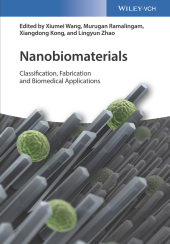 Neuerscheinungen 2018Stand: 2020-02-01 |
Schnellsuche
ISBN/Stichwort/Autor
|
Herderstraße 10
10625 Berlin
Tel.: 030 315 714 16
Fax 030 315 714 14
info@buchspektrum.de |

Xiangdong Kong, Murugan Ramalingam, XiuMei Wang, Lingyun Zhao
(Beteiligte)
Nanobiomaterials
Classification, Fabrication and Biomedical Applications
Herausgegeben von Wang, XiuMei; Ramalingam, Murugan; Kong, Xiangdong; Zhao, Lingyun
1. Auflage. 2018. XVIII, 492 S. 5 SW-Abb., 2 Farbabb. 244 mm
Verlag/Jahr: WILEY-VCH 2018
ISBN: 3-527-34067-X (352734067X)
Neue ISBN: 978-3-527-34067-5 (9783527340675)
Preis und Lieferzeit: Bitte klicken
Written by an international team of editors and contributors from renowned universities and institutes, this book addresses the latest research in the field of nanobiomaterials, covering nanotechnologies for their fabrication, developments in biomedical applications, and the challenges of biosafety in clinic uses.
Clearly structured, the volume defines the scope and classification of the field, resulting in a broad overview from fundamental principles to current technological advances, and from materials synthesis to biomedical applications along with future trends.
Part I Introduction 1
1 Nanobiomaterials: State of the Art 3
JingWang, Huihua Li, Lingling Tian, and Seeram Ramakrishna
1.1 Introduction 3
1.1.1 Properties of Nanobiomaterials 4
1.1.2 Interaction between Nanobiomaterials and Biological System 4
1.1.3 Biocompatibility and Toxicity of Nanobiomaterials 5
1.2 Nanobiomaterials for Tissue Engineering Applications 6
1.2.1 Vascular Tissue Engineering 7
1.2.2 Neural Tissue Engineering 9
1.2.3 Cartilage Tissue Engineering 12
1.2.4 Bone Tissue Engineering 13
1.3 Nanobiomaterials for Drug Delivery Applications 15
1.3.1 Carbon-Based Nanobiomaterials 15
1.3.2 Silica Nanoparticles 17
1.3.3 Polymer-Based Nanomaterials 18
1.4 Nanobiomaterials for Imaging and Biosensing Applications 18
1.4.1 Polymer-Based Nanobiomaterials 19
1.4.2 Quantum-Dot-Based Nanobiomaterials 19
1.4.3 Magnetic Nanoparticles 21
1.4.4 Gold Nanobiomaterials 22
1.4.5 Organic-Inorganic-Based Materials 23
1.4.6 CNT-Based Nanobiomaterials 23
1.5 Conclusions and Perspectives 24
References 25
Part II Classification of Nanobiomaterials 37
2 Metallic Nanobiomaterials 39
Magesh S, Vasanth G, Revathi A, Geetha Manivasagam, and Murugan Ramalingam
2.1 Introduction 39
2.2 Conventional to Ultrafine-Grained Materials ? A Novel Transformation 40
2.2.1 Bottom-Up Approach 42
2.2.2 Top-Down Approach 43
2.3 Severe Plastic Deformation (SPD) 43
2.3.1 Equal Channel Angular Pressing (ECAP) 43
2.3.2 High-Pressure Torsion (HPT) 45
2.3.3 Accumulative Roll Bonding (ARB) 46
2.3.4 Other SPD Processes 47
2.3.4.1 Multipass Caliber Rolling (MPCR) 47
2.3.4.2 DisintegratedMelt Deposition (DMD) 47
2.4 Mechanical Behavior of Metallic Nanobiomaterials 48
2.5 Corrosion 49
2.5.1 Corrosion Mechanism 50
2.5.2 Passivation of Metallic Biomaterials 50
2.5.3 Biological Environment and Its Influence on Corrosion of Metallic Biomaterials 51
2.5.4 Corrosion Behavior of Metallic Nanobiomaterials 53
2.6 Wear 54
2.6.1 Wear Assessment 55
2.6.2 Wear Aspects of Metallic Nanobiomaterials 56
2.6.2.1 Improved Wear Resistance of Metallic Nanobiomaterials 56
2.6.2.2 Detrimental Wear Properties of Metallic Nanobiomaterials 57
2.6.2.3 No Effect 57
2.7 Biocompatibility of Metallic Nanobiomaterials 57
2.8 Biomedical Application of Metallic Nanobiomaterials 59
2.9 Future Aspects 59
References 60
3 Polymeric Nanobiomaterials 65
Deepti Rana, Keerthana Ramasamy, Samad Ahadian, Geetha Manivasagam, XiumeiWang, and Murugan Ramalingam
3.1 Introduction 65
3.2 Types of Polymeric Nanobiomaterials 66
3.3 Polymeric Nanofibers 67
3.4 Polymeric Nanofibers to Provide Microenvironmental Cues 69
3.5 Biological Relevance of Polymeric Nanofibers 71
3.6 Recent Trends in Polymeric Nanofibers 72
3.6.1 Hybrid Nanofibers 72
3.6.2 Gradient Nanofibers 74
3.7 Applications of Nanofibers in RegenerativeMedicine 75
3.7.1 Bone Tissue Engineering 75
3.7.2 Nerve Tissue Engineering 77
3.7.3 Vascular Tissue Engineering 78
3.8 Concluding Remarks 79
Acknowledgment 80
References 80
4 Carbon-Based Nanobiomaterials 85
Samad Ahadian, Farhad Batmanghelich, Raquel Obregón, Deepti Rana, Javier Ramón-Azcón, Ramin Banan Sadeghian, and Murugan Ramalingam
4.1 Introduction 85
4.2 Tissue Engineering 87
4.2.1 Neural Tissue Engineering 87
4.2.1.1 CNTs in Neural Tissue Engineering 88
4.2.1.2 Graphene in Neural Tissue Engineering 89
4.2.2 Bone Tissue Engineering 89
4.2.2.1 CNTs in Bone Tissue Engineering 89
4.2.2.2 Graphene in Bone Tissue Engineering 92
4.3 Gene and Drug Delivery 92
4.3.1 CNTs in Delivery Systems 92
4.3.2 Graphene in Delivery Systems 93
4.4 Biosensing 93
4.4.1 CNTs in Biosensing 93
4.4.2 Graphene in Biosensing 94
4.5 Biomedical Imaging 95
4.5.1 CNTs in Biomedical Imaging 95
4.5.2 Graphene in Biomedical Imaging 95
4.6 Conclusions 97
References 97
Part III Nanotechnology-Based Approaches in Biomaterials Fabrications 105
5 Molecular Self-Assembly for Nanobiomaterial Fabrication 107
Ling Zhu, Yanlian Yang, and ChenWang
5.1 Introduc


